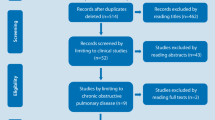Abstract
Arterial blood gas (ABG) has an important role in the clinical assessment of patients with acute exacerbations of chronic obstructive pulmonary disease (AECOPD). Because of ABG complications, an alternative method is beneficial. We have trained and tested five artificial neural networks (ANNs) with venous blood gas (VBG) values (pH, PCO2, HCO3, PO2, and O2 saturation) as inputs, to predict ABG values in patients with AECOPD. Venous and arterial blood samples were collected from 132 patients. Using the data of 106 patients, the ANNs were trained and validated by back-propagation algorithm. Subsequently, data from the remainder 26 patients was used for testing the networks. The ability of ANNs to predict ABG values and to detect significant hypercarbia was assessed and the results were compared with a linear regression model. Our results indicate that the ANNs provide an accurate method for predicting ABG values from VBG values and detecting hypercarbia in AECOPD.

Similar content being viewed by others
References
Barker, W. J., Arterial puncture and cannulation. In: Roberts, J. R., and Hedges, J. R. (Eds.), Clinical Procedures in Emergency Medicine, 3rd edition. Saunders, Philadelphia, pp. 308–322, 1998.
Mortenson, J. D., Clinical sequelae from arterial needle puncture, cannulation and incision. Circulation. 35:1118–1125, 1967.
McGillivray, D., Ducharme, F. M., Charron, Y., Mattimoe, C., and Treherne, S., Clinical decision making based on venous versus capillary blood gas values in the wellperfused child. Ann. Emerg. Med. 34:58–63, 1999.
Kelly, A. M., Kyle, E., and McAlpine, R., Venous PCO2 and pH can be used to screen for significant hypercarbia in emergency patients with acute respiratory disease. J. Emerg. Med. 22:15–19, 2002.
Kelly, A. M., Kerr, D., and Middleton, P., Validation of venous PCO2 to screen for arterial hypercarbia in patients with chronic obstructive airways disease. J. Emerg. Med. 28 (4)377–379, 2005.
Murphy, R., Thethy, S., Raby, S., Beckley, J., Terrace, J., Fiddler, C., et al., Capillary blood gases in acute exacerbations of COPD. Respir. Med. 100 (4)682–686, 2006.
Ibrahim, I., Ooi, S. B., Yiong Huak, C., Sethi, S., Point-of-care bedside gas analyzer: limited use of venous PCO2 in emergency patients. J Emerg Med. 2008 (in press).
Ak, A., Ogun, C. O., Bayir, A., Kayis, S. A., and Koylu, R., Prediction of arterial blood gas values from venous blood gas values in patients with acute exacerbation of chronic obstructive pulmonary disease. Tohoku J Exp Med. 210 (4)285–290, 2006.
Chu, Y. C., Chen, C. Z., Lee, C. H., Chen, C. W., Chang, H. Y., and Hsiue, T. R., Prediction of arterial blood gas values from venous blood gas values in patients with acute respiratory failure receiving mechanical ventilation. J. Formos. Med. Assoc. 102 (8)539–543, 2003.
Razi, E., and Moosavi, G. A., Comparison of arterial and venous blood gases analysis in patients with exacerbation of chronic obstructive pulmonary disease. Saudi Med. J. 28 (6)862–865, 2007.
Gambino, S. R., Comparisons of pH in human arterial, venous and capillary blood. Am. J. Clin. Pathol. 32:298–300, 1959.
Searcy, R. L., Gordon, G. F., and Simms, N. M., Choice of blood for acid-base studies (letter). Lancet. 41:12–32, 1963.
Long, A. P., Jr, Venous or arterial blood gas measurement (letter). JAMA. 217:1706, 1971.
Forster, H. V., Dempsey, J. A., Thomson, J., Vidruk, E., and do Pico, G. A., Estimation of arterial PO2, PCO2, pH and lactate from arterialised venous blood. J. Appl. Physiol. 32:134–137, 1972.
Brooks, D., and Wynn, V., Use of venous blood for pH and carbon dioxide studies especially in respiratory failure and during anaesthesia. Lancet. 1:227–230, 1959.
Paine, E. G., Boutwell, J. H., and Soloff, L. A., The reliability of arterialised venous blood for measuring arterial pH and PCO2. Am. J. Med. Sci. 242:431–434, 1961.
Gambino, S. R., Normal values for adult human venous plasma pH and CO2 content. Am. J. Clin. Pathol. 32:294–297, 1959.
Kelly, A. M., McAlpine, R., and Kyle, E., Venous pH can safely replace arterial pH in the initial evaluation of patients in the emergency department. Emerg. Med. J. 18:340–342, 2001.
Ma, O. J., Rush, M. D., Godfrey, M. M., et al., Arterial blood gas results rarely influence emergency physician management of patients with suspected diabetic ketoacidosis. Acad. Emerg. Med. 10:836–841, 2003.
Gokel, Y., Paydas, S., Koseoglu, Z., et al., Comparison of blood gas and acid-base measurements in arterial and venous blood samples in patients with uraemic acidosis and diabetic ketoacidosis in the emergency room. Am. J. Nephrol. 20:319–323, 2000.
Cross, S. S., Harrison, R. F., and Kennedy, R. L., Introduction to neural networks. Lancet. 5:1075–1079, 1995.
Baxt, W. G., Application of artificial neural networks to clinical medicine. Lancet. 5:1135–1138, 1995.
Bos, M., Bos, A., and van der Linden, W. E., Data processing by neural networks in quantitative chemical analysis. Analyst. 5:323–328, 1993.
Ala-Korpela, M., Hiltunen, Y., and Bell, J. D., Quantification of biomedical NMR data using artificial neural network analysis: lipoprotein lipid profiles from 1H NMR data of human plasma. NMR Biomed. 5:235–244, 1995.
Burge, S., and Wedzicha, J. A., COPD exacerbations: definitions and classifications. Eur. Respir. J. Suppl. 41:46s–53s, 2003.
Dariani, S., Keshavarz, M., Parviz, M., Raoufy, M. R., and Gharibzadeh, S., Modeling force-velocity relation in skeletal muscle isotonic contraction using an artificial neural network. Biosystems. 90 (2)529–534, 2007.
Tu, J. V., Advantages and disadvantages of using artificial neural networks versus logistic regression for predicting medical outcomes. J. Clin. Epidemiol. 49:1225–1231, 1996.
Lin, C. S., Li, Y. C., Mok, M. S., Wu, C. C., Chiu, H. W., and Lin, Y. H., Neural network modeling to predict the hypnotic effect of propofol bolus induction. Proc AMIA Symp. 2002:450–454, 2002.
Author information
Authors and Affiliations
Corresponding author
Rights and permissions
About this article
Cite this article
Raoufy, M.R., Eftekhari, P., Gharibzadeh, S. et al. Predicting Arterial Blood Gas Values from Venous Samples in Patients with Acute Exacerbation Chronic Obstructive Pulmonary Disease Using Artificial Neural Network. J Med Syst 35, 483–488 (2011). https://doi.org/10.1007/s10916-009-9384-4
Received:
Accepted:
Published:
Issue Date:
DOI: https://doi.org/10.1007/s10916-009-9384-4




